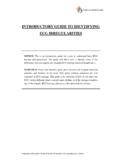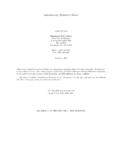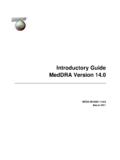Transcription of INTRODUCTORY GUIDE TO IDENTIFYING ECG IRREGULARITIES
1 DailyCare BioMedical Inc. INTRODUCTORY GUIDE TO IDENTIFYING ECG IRREGULARITIES NOTICE: This is an INTRODUCTORY GUIDE for a user to understand basic ECG tracings and parameters. The GUIDE will allow user to identify some of the differences between regular and irregular ECG tracings based on Lead I alone. WARNINGS: Please note that this GUIDE does not cover all irregular electrical activities and rhythms of the heart. This GUIDE contains simulated and real examples of ECG tracings. This GUIDE is for reference ONLY. If you find your ECG tracing different from a normal sinus rhythm, or if the tracing resembles any of the irregular ECG tracings, please consult a physician for advices.
2 Proprietary information of DailyCare BioMedical Inc. No reproduction is allowed. DailyCare BioMedical Inc. CONTENTS CARDIO BASIC FUNCTION OF THE HEART:..1 CONDUCTION SYSTEM OF THE HEART:..2 ABOUT ARRHYTHMIA:..3 EXAMPLE OF 12-LEAD ECG:..3 BASIS OF THE ELECTROCARDIOGRAM (ECG)..4 UNDERSTANDING ECG PARAMETERS:..4 ECG WAVES AND ECG NORMAL SINUS SINUS SINUS SUPRAVENTRICULAR TACHYCARDIA (SVT)..8 ATRIAL FIBRILLATION, ATRIAL FIBRILLATION, ATRIAL VENTRICULAR VENTRICULAR VENTRICULAR SINUS MISSED PAROXYSMAL ATRIAL TACHYCARDIA (PAT)..13 NODAL LEFT VENTRICULAR FIRST DEGREE A-V HEART BLOCK:..14 Proprietary information of DailyCare BioMedical Inc.
3 No reproduction is allowed. DailyCare BioMedical Inc. SECOND DEGREE A-V HEART BLOCK:..15 THIRD DEGREE A-V BLOCK:..15 RIGHT BUNDLE BRANCH BLOCK (RBBB)..16 LEFT BUNDLE BRANCH BLOCK (LBBB)..16 PREMATURE ATRIAL CONTRACTION (PAC)..17 PREMATURE NODAL CONTRACTION (PNC)..17 PREMATURE VENTRICULAR CONTRACTION (PVC)..18 TWO PVCS TOGETHER OTHER IRREGULAR REVERSE PACEMAKER SMALL NOISE GLOSSARY:..25 12-LEAD ECG ANALOGY BY LEAD LEAD LEAD LEAD LEAD LEAD Proprietary information of DailyCare BioMedical Inc. No reproduction is allowed. DailyCare BioMedical Inc. Cardio System Basic Function of the Heart: The heart has 4 chambers that act together to pump blood throughout the body.
4 The 2 smaller upper chambers are called atria, and the larger lower chambers are called ventricles. The right atrium receives oxygen-depleted blood coming back from the body via 2 large veins: the superior vena cava and inferior vena cava. The right atrium pumps this blood into the right ventricle, which then pumps the blood into the lungs, which is oxygenated. The blood then comes back into the left atrium, which is then pumped into the left ventricle. The left ventricle then pumps the blood back to the circulatory system via the aorta, the largest artery in the body. The pressure that the left ventricle exerts to keep the blood moving throughout the whole body is the blood pressure.
5 Proprietary information of DailyCare BioMedical Inc. No reproduction is allowed. 1 DailyCare BioMedical Inc. Conduction System of the Heart: The chambers of the heart pump with the automatic discharge of electricity from the sinoatrial (SA) node, a group of specialized cells located in the right atrium, also known as the heart s natural pacemaker. On average, there are 60 to 100 times discharges per minute. When the SA node discharges, both atria contract, and the electrical impulse is relayed to the atrioventricular (AV) node, located between the 2 ventricles. The electrical wave is then transmitted from the AV node to the lower chambers of the heart, or ventricles, via the bundle branches.
6 The ventricles will contract and pump blood to the whole body. The normal delay between the atrium and ventricle contractions is to seconds. By studying the electrical activity that results when heart muscle cells contract, we gain insight to the health and workings of the heart. These electrical activities can be detected, recordered and studied with an electrocardiograph, for example ReadMyHeart. Proprietary information of DailyCare BioMedical Inc. No reproduction is allowed. 2 DailyCare BioMedical Inc. About Arrhythmia: Arrhythmia is an abnormal or irregular hear rhythm resulting from any changes, deviation or malfunction in the conduction system of the heart.
7 Early diagnosis of an arrhythmia is very important. This is because the longer an arrhythmia lasts without any detection or treatment, the greater the chances of permanent damage and additional heart dysfunction. Example of 12-Lead ECG: (Arrhythmia) Proprietary information of DailyCare BioMedical Inc. No reproduction is allowed. 3 DailyCare BioMedical Inc. Basis of the Electrocardiogram (ECG) Understanding ECG Parameters: A normal ECG Waveform (Lead I) Reading the graph The Y-axis represents voltage in mV. The bar indicated below represents 1 millivolt (mV). This denotes the electrical strength of the signal.
8 Therefore, each big square represent mV and each small square represent The X-axis represents time in seconds. Each big square represent seconds. Therefore, each small square represents seconds. bar 1 mV seconds Proprietary information of DailyCare BioMedical Inc. No reproduction is allowed. 4 DailyCare BioMedical Inc. ECG waves and parameters The following is a summary of the ECG wave morphologies and parameters that users can use as a GUIDE to understand more about their ECG recordings. P wave: The P wave results from atria contraction. P wave is generally about 1 box wide or 1 box tall. P wave that exceeds these might indicate atria hypertrophy, , enlargement.
9 PR Interval: The PR interval is measured from the start of the P wave to the start of Q wave. It represents the duration of atria depolarization. Regular duration is from to seconds, about 3 to 5 box wide. If the PR interval is greater than seconds, then an AV block might be present. QRS Complex: The QRS complex is measured from the start of Q wave to the end of S wave. It represents the duration of ventricle depolarization. Regular duration is from seconds, about 2 to 3 box wide. If duration is longer, it might indicate presence of bundle branch blocks. QT/QTc: The Q T/QTc is measured from the start of the Q wave to the end of T wave.
10 QT interval represents the duration of activation and recovery of the ventricular muscle. This duration varies inversely with the heart rate. The regular QTc is approximately seconds or an accurate measurement, it is corrected with the heart rate with the following formula to get QTc: QTc = QT + (HR 60) ST Segment: The ST segment is measured from end of S wave, J point, to the start of T wave. This segment is important in IDENTIFYING pathology such as myocardial infarctions (elevations) and ischemia (depressions). Proprietary information of DailyCare BioMedical Inc. No reproduction is allowed. 5 DailyCare BioMedical Inc. ECG Parameters: Parameters Reference Range Average Heart Rate (HR) 60 < HR <100 bpm ST Segment (ST) -2 < ST < +2 mm QRS Interval (QRS) < QRS < sec PR interval ~ sec ~ sec /0.






